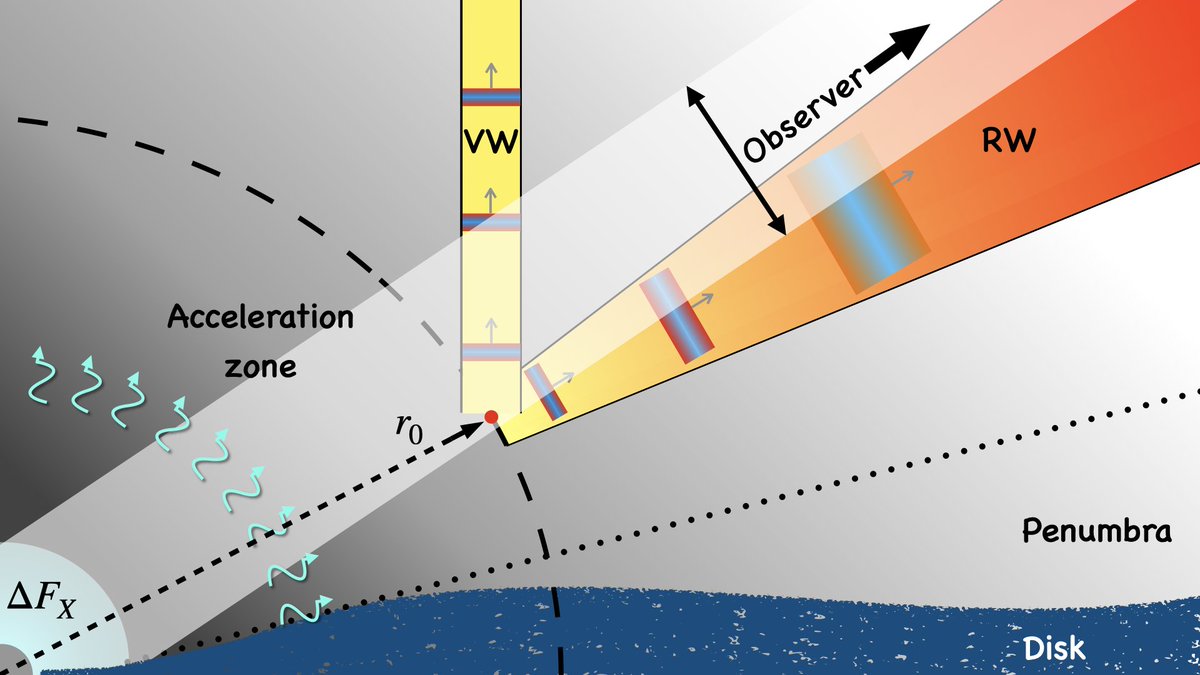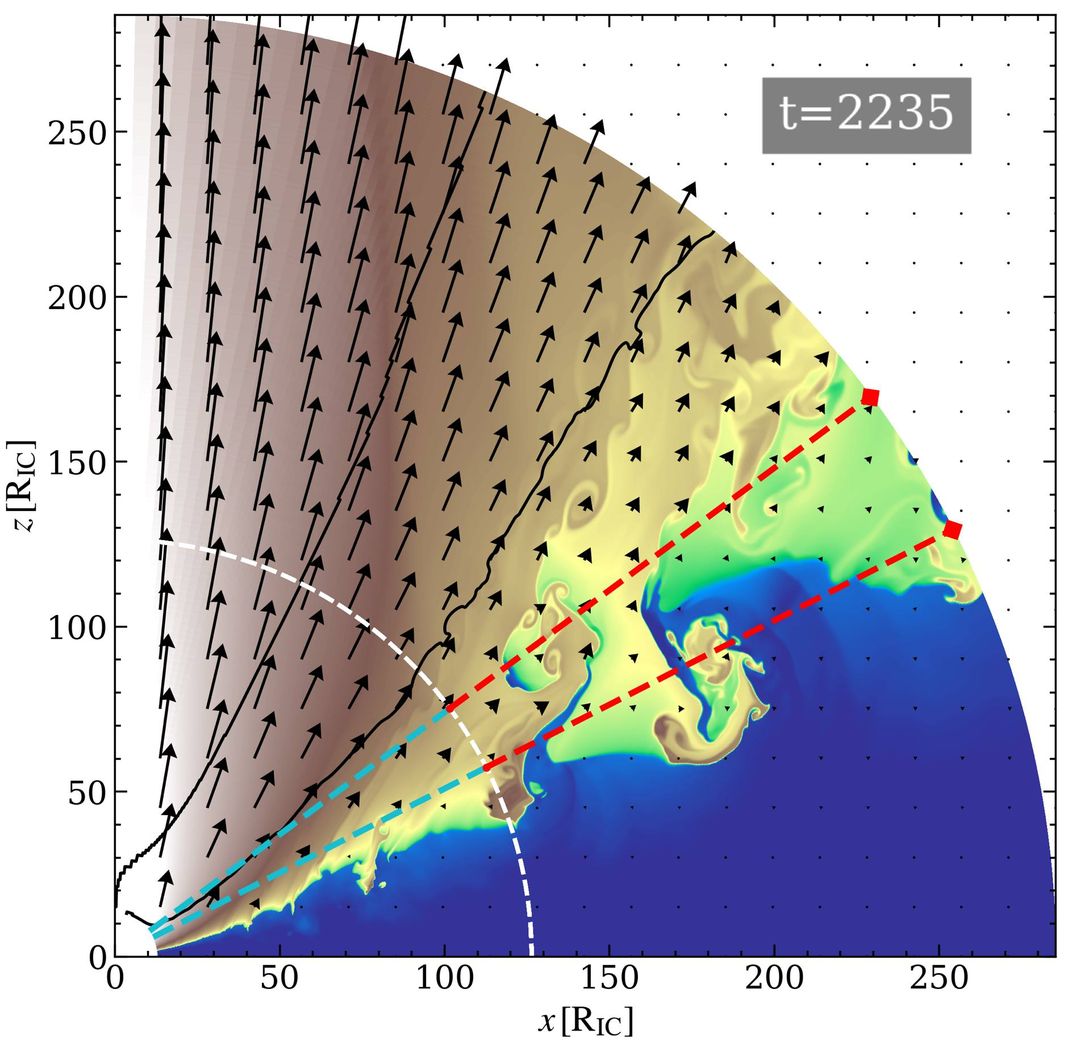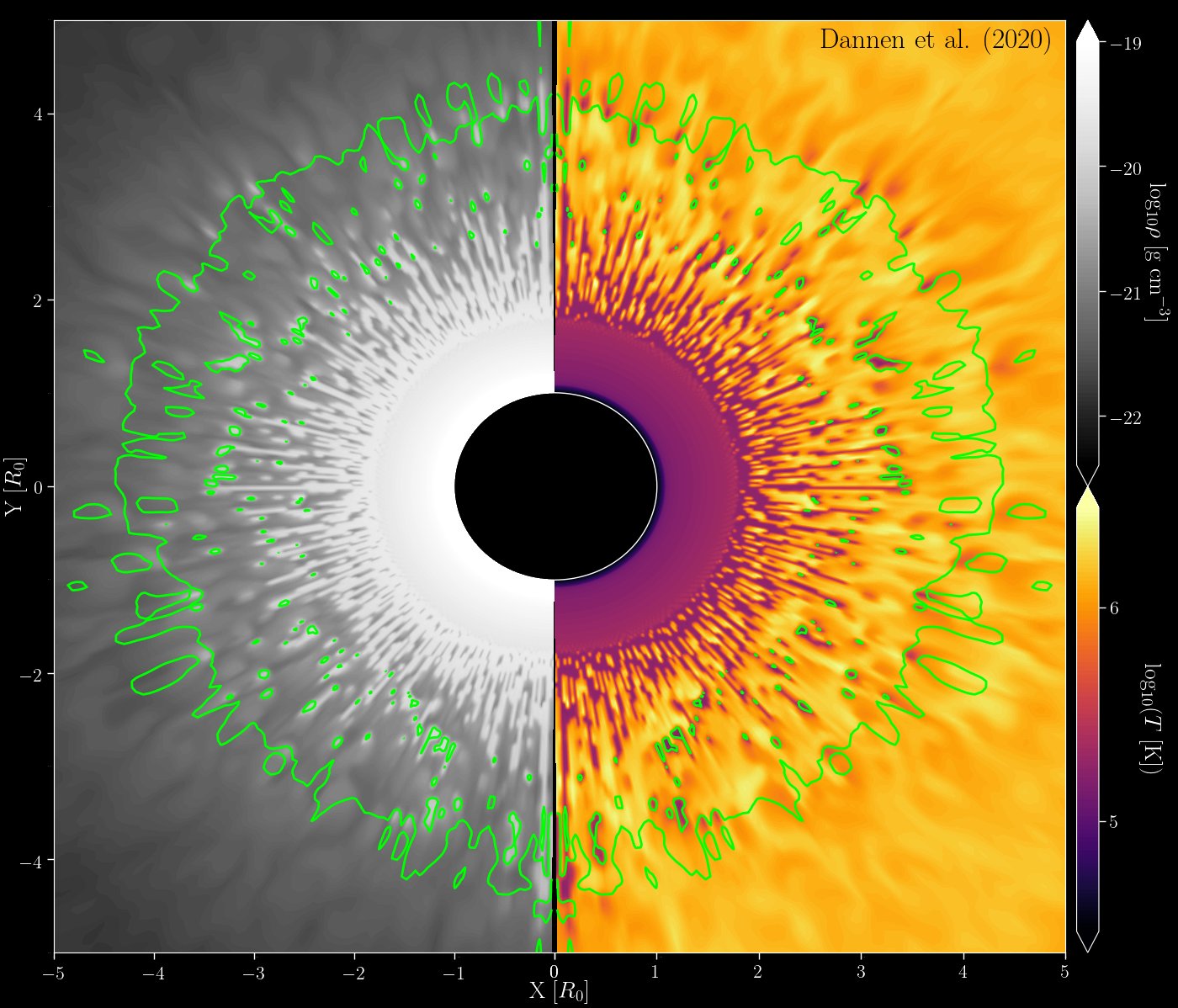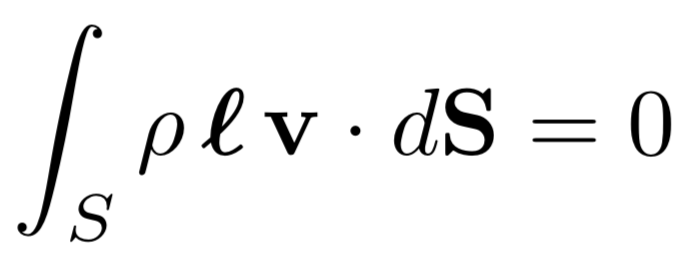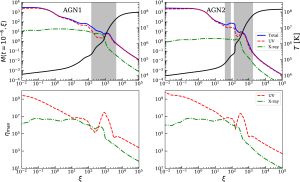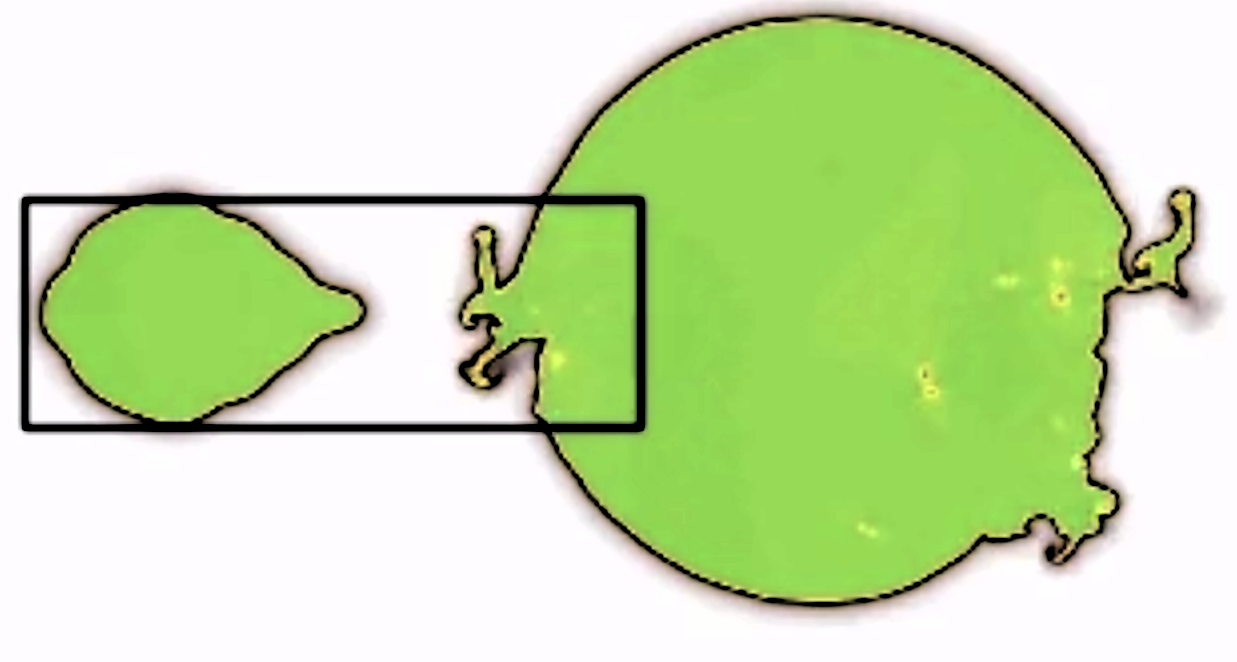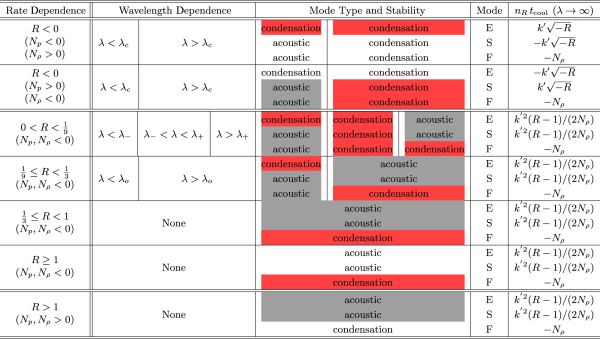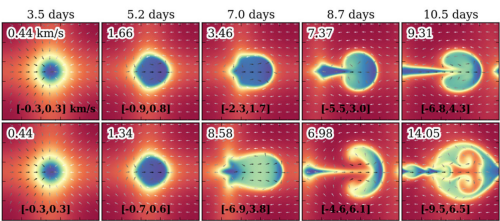Ultrafast Outflows
https://trwaters.github.io/dynamicalTI/Over the last decade, it has become established that ultrafast outflows (UFOs) are commonplace in AGN. Likely launched from the inner regions of the supermassive black hole's accretion disk, UFOs have velocities in the range 9,000 - 90,000 km/s. (For comparison, the solar wind speed varies between 300 and 800 km/s). They are most often detected in hard X-ray spectra, mainly in absorption lines of H-like and He-like Fe ions. However, they have also been identified in soft X-rays, within lines that, remarkably, can have the same blueshift, prompting the need to explain how this lower ionization gas component can co-exist at the same velocity as the hotter plasma containing only Fe ions. Here we find that UFOs are expected to be thermally unstable; the lower ionization clumps that form will have the same velocity and can therefore account for these observations.
Multiphase AGN disk winds
https://trwaters.github.io/multiphaseAGNdiskwinds/The X-ray sky is filled with millions of bright point sources that we know to be hot plasma accreting onto supermassive black holes. At light year distances from such a black hole, the atmosphere of the accretion disk is irradiated by the central X-rays and heated to high enough temperatures to drive a wind. Here we model the dynamics of this system, identifying a characteristic radius where the wind becomes multiphase due to local thermal instability operating within large scale vortices present in the upper layers of the disk atmosphere. Googling 'black hole tsunamis' will show that this result generated a good deal of media attention, all stemming from this NASA press release. Additionally, a popular scicommer covered this result on youtube.
Theoretical absorption line profiles of thermally driven outflows
http://www.physics.unlv.edu/astro/clumpywindsims-lps.htmlMore than half of all galaxies classified as active galactic nuclei (AGN) in the nearby universe show blueshifted absorption lines in the X-ray band of their spectra. The blueshifts indicate outflowing gas, and ions that can absorb X-ray photons only form in a high temperature plasma. In the literature these ionized outflows are referred to as 'warm absorbers' -- 'warm' because the existence of these spectral features are often absent, implying that the plasma can be so hot that any ions present are mostly stripped of their electrons. In this study, led by Daniel Proga and PhD student Shalini Ganguly, we show that clumpy outflow models (see below) may explain this phenomenon. The method used to calculate line profiles builds upon my previous work and has general applicability.
Clumpy AGN outflows
http://www.physics.unlv.edu/astro/clumpywindsims.htmlObservations of AGN outflows reveal them to be clumpy. Here is the first ever demonstration that classical thermal instability can be triggered in AGN outflow models, which may ultimately explain such observations. This project, led by Daniel Proga and PhD student Randall Dannen, was the subject of both a NASA press release and a UNLV highlight.
Outflows from inflows
https://trwaters.github.io/OutflowsFromInflows/A classic solution in astrophysical gas dynamics is spherically symmetric accretion onto a black hole. Despite being a highly idealized solution, one would not expect an infintesimal change in the boundary conditions to result in a qualitatively different solution. Yet that is precisely what happens: a tiny density inhomogeneity placed far enough away from the black hole will not permit pure inflow. We demonstrated that an outflow must develop as a consequence of angular momentum conservation. More generally, we showed that solutions to the 'inhomogenous Bondi problem' must satisfy the integral condition shown here.
Calculations of radiation forces in AGN
http://www.physics.unlv.edu/astro/xstartables.htmlThere is a famous characteristic luminosity in astrophysics known as the Eddington limit, which is the luminosity that would give rise to a radiation force equal to the force of gravity, allowing gas to levitate at this limit and get pushed outward above it. The Eddington limit applies to radiation pressure acting on free electrons. If only hydrogen is fully ionized, then there will typically be an enormous opacity due to ions heavier than hydrogen. In this project, led by PhD student Randall Dannen, we calculated the radiation force due to this 'line opacity'. We find that radiation forces can surpass gravity in sources emitting far below the Eddington limit, so that radiation driven outflows are expected to be commonplace in AGN.
Cloud coalescence
http://www.physics.unlv.edu/astro/WP19bSims.htmlThe word 'coalescence' in astrophysics is typically used to describe one of the most energetic events in the universe: the merging of binary compact objects such as black holes. On the opposite end of the energy spectrum is a purely gas dynamical process that causes astrophysical clouds to coalesce. This occurence, uncovered while exploring the nonlinear dynamics of interacting clouds formed from thermal instability, is shown to be a genuine instability that is generic to multiphase environments.
Non-isobaric thermal instability
http://www.physics.unlv.edu/astro/WP19aSims.htmlThermal instability (TI) is a linear instability of non-adiabatic gas dynamics. While the linear theory was thoroughly worked out in 1965 by George Field, in this work we clarified some subtleties that arise when clouds become very large, meaning one side loses causal contact with the other (via communication through sound waves). We identified 7 regimes of instability, as summarized in the Table at left, which reveals that very large wavelength sound waves do not even exist in an unstable plasma unless it is unstable by both the isobaric and isochoric instability criteria identified by Field. The animations reveal that large (i.e. non-isobaric) clouds formed from TI tend to oscillate, and the cloud coalescence project above further demonstrates that such oscillations are also a generic property of multiphase gas dynamics.
Cloud formation and acceleration
http://www.physics.unlv.edu/astro/wp16sims.htmlThis project follows up one led by Daniel Proga, where we laid some important ground work for several of the above projects, as there we showed how to simulate cloud formation due to thermal instability while self-consistently accounting for the radiation force that must become important as ions recombine. In this one we showed that adding flux variability can have interesting dynamical effects. And in another followup paper, we showed that common doublet lines can in principle be used to detect cloud acceleration along the line of sight.
